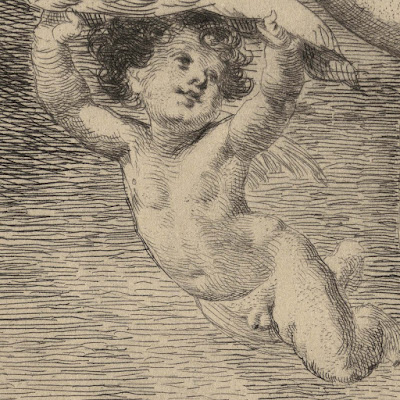Dominique Vivant Denon (aka Vivant De
Non; Vivant Denon; Baron Dominique-Vivant Denon) (1747–1825)
“Two Lions and a Lioness” (Deux lions et
une lionne), c1795 (my attribution of this date is based on the time period
that the printer/publisher of the lettered edition, NC Aubourg, was
active), after the painting of the same composition by Martin Ferdinand
Quadal (1736–1808).
Etching with pale plate tone on heavy
wove paper.
Size: (sheet) 42.2 x 58.7 cm; (plate) 33.2
x 46.7 cm; (image borderline) 30.5 x 41.7 cm
Numbered on plate above the image
borderline: (right) “42.”
Inscribed on plate within the image
borderline: (along the lower edge at right) “M F Quabal […?] V Denon Sul[p]t”.
Lettered on plate below the image
borderline: (left) “Quadal pinx:”; (right) “Denon Sculp:”
Lifetime impression before lettering for
publication with the address of NC Aubourg.
TIB 12101.290 (Petra ten-Doesschate Chu
1985, “The Illustrated Bartsch: Dominique Vivant Dennon: French Masters of the
Nineteenth Century”, vol. 121, Part 1, New York, Abaris Books, p, 231); IFF 223
(Inventaire du Fonds Français: Bibliothèque Nationale, Département des
Estampes, Paris, 1930).
The British Museum offers a description
of this print: (https://www.britishmuseum.org/research/collection_online/collection_object_details.aspx?objectId=1511767&partId=1&searchText=denon+Quadal&page=1)
Condition: a superb, richly inked and
faultless impression with wide margins in near pristine condition (i.e. there
are no tears, holes, folds, abrasions, stains, foxing or signs of handling).
I am selling this large, exceptionally
rare and very beautiful etching for the total cost of AU$300 (currently US$214.30/EUR187.71/GBP160.92
at the time of this listing) including postage and handling to anywhere in the
world (but not, of course, any import duties/taxes imposed by some countries).
If you are interested in purchasing this
near faultless impression exemplifying Denon’s magical ability to invest his
portrayed subjects with the spirit of life, please contact me
(oz_jim@printsandprinciples.com) and I will send you a PayPal invoice to make
the payment easy.
This print has been sold


























































